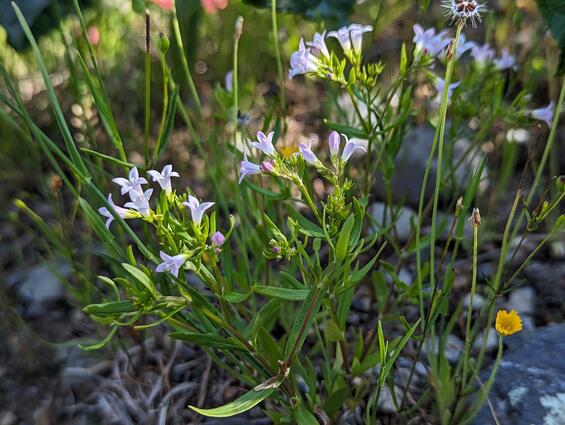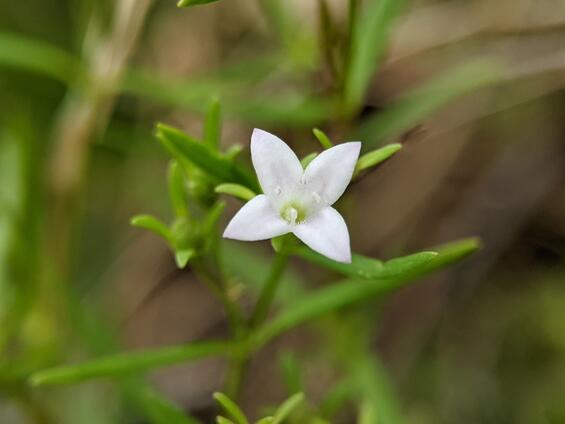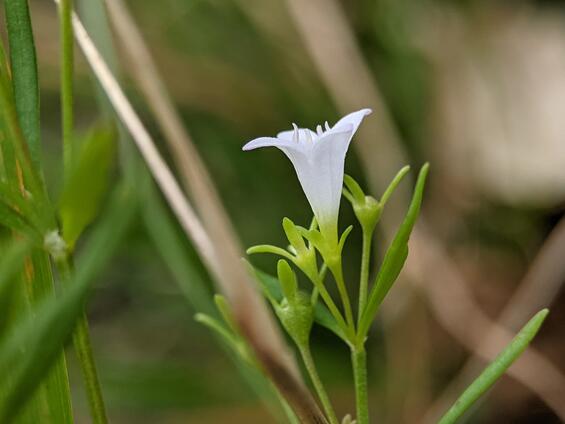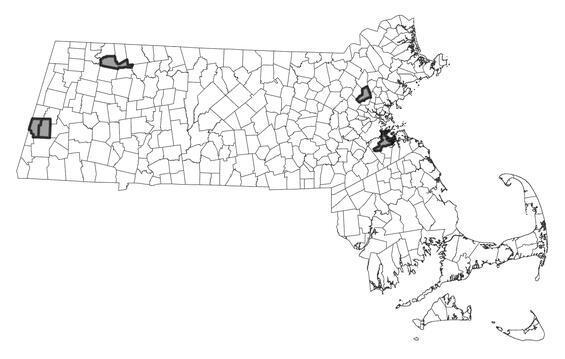- Scientific name: Houstonia longifolia Gaertn.
- Species of Greatest Conservation Need (MA State Wildlife Action Plan)
- Endangered (MA Endangered Species Act)

Long-leaved bluet (Image by Claire O'Neill, Earthwise Aware)
Description
Long-leaved bluet (Houstonia longifolia) is an herbaceous perennial wildflower of the madder family (Rubiaceae), which inhabits open rocky woods, glades, and ledges. Plants produce rosettes of leaves in the spring from which multiple, usually branching, flowering stems arise. The basal rosettes die back by the time the plant comes into flower in late spring. Stems are 10-25 cm (~4–10 in) tall, four-angled in cross section, and bear opposite, sessile, linear or oblong leaves. The leaves are smooth-edged (lacking teeth or lobes) and 1-3 cm (~1/2–1 ¼ in) long by 3-5 mm (0.12-0.2 in) wide. Clusters of four-lobed pinkish to white flowers are produced at the tops of the stems. The lower portions of the petals are fused into a funnel-shaped tube about 7 mm (0.28 in) long; the free portions of the petals are about 2 mm (0.08 in) long and bend back (recurve) so they are perpendicular to the tube. Sepals are 1.5 to 2.7 mm (0.06-0.1 in).
Specific characteristics include:
- opposite, entire, linear leaves; opposing leaves are connected at the base by a pale, triangular stipule (leaf-like appendage),
- square stem,
- four-lobed pink or white flowers with their free tips much shorter than the flower-tube,
- flowers produced only from the tips of the stems.
Two other species of bluets, little bluet (H. caerulea) and large bluet (H. purpurea var. calycosa) are known from Massachusetts. Small bluet has only one flower borne at the top of the stem, with petals that do not recurve; the leaves have distinct petioles. Large bluet, an exotic species, has broader leaves (>5 mm [0.2 in]) and longer sepals (>3 mm [0.12 in]) than the rare species.

Images by Claire O'Neill, Earthwise Aware

Life cycle and behavior
Flowering occurs throughout early and midsummer; fruit are present in late summer. This is a perennial species.
Population status
Long-leaved bluet is listed under the Massachusetts Endangered Species Act as endangered. All listed species are protected from killing, collecting, possessing, or sale and from activities that would destroy habitat and thus directly or indirectly cause mortality or disrupt critical behaviors. MassWildlife’s Natural Heritage & Endangered Species Program has 20 records from 6 counties: Berkshire, Franklin, Middlesex, Norfolk, Suffolk, and Worcester. Six of these records have been observed since 1999.
Distribution and abundance
Long-leaved bluet ranges from Maine to Saskatchewan, south to Arkansas and South Carolina.

Distribution in Massachusetts. 2000-2025. Based on records in the Natural Heritage Database.
Habitat
Long-leaved bluet grows in dry, sunny or lightly shaded habitats. Rocky openings with ledges and bedrock exposures are particularly favorable; dry sterile fields, gravel banks, roadsides, quarries and similar human-influenced habitats also provide suitable habitat. Some associated species include hairgrass (Deschampsia flexuosa), little bluestem (Schizachyrium scoparium), poverty oatgrass (Danthonia spicata), stiff aster (Ionactis linariifolius), eastern red cedar (Juniperus virginiana), oaks (Quercus spp.), hickories (Carya spp.), blueberries (Vaccinium spp.), and haircap moss (Polytrichum commune).
Healthy habitats are vital for supporting native wildlife and plants. Explore habitats and learn about conservation and restoration in Massachusetts.
Threats
Competition from exotic invasive and aggressive native species due to natural succession and lack of natural disturbance or management is a potential threat to long-leaved bluet populations.
Conservation
All populations are in locations where natural processes or human activities have produced open, sunny habitat. Competition from exotic invasive and aggressive native species due to natural succession and lack of natural disturbance or management is a potential threat to Long-leaved Bluet populations. Monitoring and removal of competing vegetation should be considered as a management strategy where appropriate. All active management of rare plant populations (including invasive species removal) is subject to review under the Massachusetts Endangered Species Act, and should be planned in close consultation with the Massachusetts Natural Heritage & Endangered Species Program.
References
Gleason, H.A., and A. Cronquist. 1991. Manual of Vascular Plants of Northeastern United States and Adjacent Canada. The New York Botanical Garden, Bronx, New York, USA.
Missouriplants.com: Photographs and descriptions of the flowering and non-flowering plants of Missouri, USA [web resource]. 2007. Available at http://www.missouriplants.com/Pinkopp/Houstonia_longifolia_page.html (accessed 5/13/2010).
Contact
| Date published: | April 29, 2025 |
|---|---|
| Last updated: | August 18, 2025 |